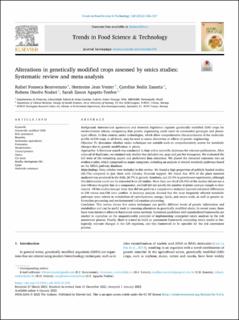| dc.contributor.author | Benevenuto, Rafael Fonseca | |
| dc.contributor.author | Venter, Hermoine Jean | |
| dc.contributor.author | Zanatta, Caroline Bedin | |
| dc.contributor.author | Nodari, Rubens Onofre | |
| dc.contributor.author | Agapito-Tenfen, Sarah Zanon | |
| dc.date.accessioned | 2022-08-16T12:48:51Z | |
| dc.date.available | 2022-08-16T12:48:51Z | |
| dc.date.created | 2022-04-29T16:17:07Z | |
| dc.date.issued | 2022 | |
| dc.identifier.citation | Trends in Food Science & Technology. 2022, 120 325-337. | en_US |
| dc.identifier.issn | 0924-2244 | |
| dc.identifier.uri | https://hdl.handle.net/11250/3012143 | |
| dc.description.abstract | Background
International agreements and domestic legislation regulate genetically modified (GM) crops for environmental release, recognizing that genetic engineering could result in unintended genotypic and phenotypic effects. In that context, omics technologies, which allow comprehensive characterization of the molecular profile of GM crops at all levels, may be used to assess alterations or effects of genetic engineering.
Objective
To determine whether omics techniques are suitable tools to comprehensively screen for metabolic changes due to genetic modification in plants.
Approaches
A literature search was conducted in four online scientific databases for relevant publications. After removal of duplicates, we retained only studies that included cry, epsps and pat/bar transgenes. We evaluated the full texts of the remaining papers and performed data extraction. We placed the extracted outcomes into an evidence table, which comprised six major categories, including an analysis of altered metabolic pathways based on the KEGG pathway database.
Main findings
Sixty articles were included in this review. We found a high proportion of publicly funded studies (86.7%) compared to just three with industry financial support. We found that 40% of the plant material analyzed was produced in the field, 26.7% in growth chambers, and 18.3% in greenhouse experiments, although this information could not be extracted from all studies. More than one third (38.4%) of the studies did not use a non-GM near-isogenic line as a comparator, and half did not specify the number of plants used per sample in their reports. All the studies (except three that did not perform a comparative analysis) reported statistical differences in GM versus non-GM omic profiles. A heatmap analysis showed that the most frequently affected metabolic pathways were related to metabolism of carbohydrates, energy, lipids, and amino acids, as well as genetic information processing and environmental information processing.
Conclusion
This review shows that omics techniques can profile different levels of genetic information and metabolism and can be useful tools in assessing alterations in genetically modified plants. In recent years, there have been intensive efforts to harmonize omics methods. Consistent guidelines with standardized frameworks are needed to capitalize on the unquestionable potential of implementing untargeted omics analyses in the risk assessment process. Finally, there is a need to build an assessment framework connecting omics results to biologically relevant changes in the GM organism, and this framework to be operable for the risk assessment process. | en_US |
| dc.language.iso | eng | en_US |
| dc.rights | Navngivelse 4.0 Internasjonal | * |
| dc.rights.uri | http://creativecommons.org/licenses/by/4.0/deed.no | * |
| dc.title | Alterations in genetically modified crops assessed by omics studies: Systematic review and meta-analysis | en_US |
| dc.title.alternative | Alterations in genetically modified crops assessed by omics studies: Systematic review and meta-analysis | en_US |
| dc.type | Peer reviewed | en_US |
| dc.type | Journal article | en_US |
| dc.rights.holder | © The Author(s) 2022 | en_US |
| dc.description.version | publishedVersion | en_US |
| cristin.ispublished | true | |
| cristin.fulltext | original | |
| cristin.qualitycode | 2 | |
| dc.identifier.doi | 10.1016/j.tifs.2022.01.002 | |
| dc.identifier.cristin | 2020210 | |
| dc.source.journal | Trends in Food Science & Technology | en_US |
| dc.source.volume | 120 | en_US |
| dc.source.pagenumber | 325-337 | en_US |

